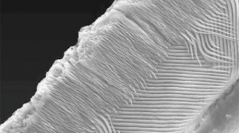

 Comptes Rendus Palevol
10 (5-6) - Pages 479-487
Comptes Rendus Palevol
10 (5-6) - Pages 479-487Many genera of arvicolid rodents (voles) contain species that spend a considerable amount of time underground. Incisors provide a considerable effort in the digging process and a difference in the enamel microstructure of incisors is expected between species that spend most of their life above ground and those who have greater specializations for a subterranean habitat. The ratio between the thicknesses of the two layers composing the enamel of the incisors has proved to be an effective proxy to infer fossorial activity of extinct forms of Arvicola but this ratio exhibited no phylogenetic signal (although lifestyle was in a greater extent related to phylogeny). We were able to infer ancestral lifestyles (of extinct populations and of nodes of the phylogeny) from enamel morphologies. Inclusion of fossils did not solve the uncertainties associated with the lifestyle for the last common ancestor of extant Arvicola species and it did not change the inferred lifestyle of several other, less inclusive, clades.
Arvicola, Europe, Enamel microstructure, Lifestyle, Ancestral state reconstruction, Phylogenetic signal